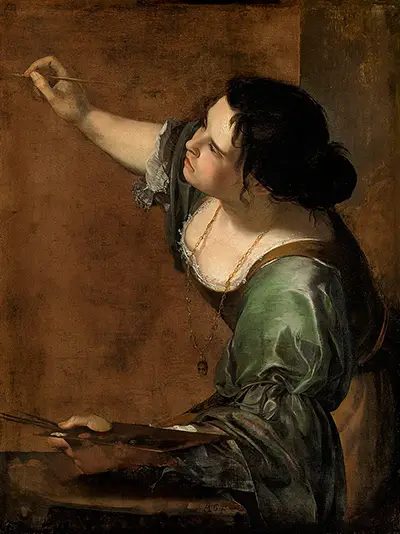This self portrait by Artemisia Gentileschi is dated to around the 1630s. She can be correctly identified thanks to a number of other attributed self portraits which exist within her career.
Artemisia's career was unfairly ignored for a number of centuries, in part due to her status as a female artist. As a result of an increased awareness of his work in the 20th century, a number of her paintings have been discovered, including this self portrait.
It was in 1935 that the first record of this particular composition would appear, with almost no knowledge of the piece existing before that point. This is the case for a number of her works, and there still today remains a considerable amount that we do not know about the artist's lfe and career.
Description
This self portrait can be described as an allegorical piece, where her artistic career is shown to the viewer. She holds an easel in her left hand, whilst holding out a brush in the right. We see a detailed artwork to the left hand side of a male portrait, whose pose is directed towards the artist.
Artemisia was known to be a colourful, extroverted character and she enjoyed the attention and fame which came during the high points of her career. She chooses here to look directly at the viewer, giving us a part of her personality. She would have been in her late thirties, or older, at the time of this self portrait.
The Baroque era was full of portraits in this manner, where the trade of the sitter was displayed for all to see. In other self portraits, Gentileschi would instead portray her as a character, though with the understanding that it was her within the painting. This helped to make her a recognisable figure in various parts of Italy, creating something of an artistic brand.
The lighting within this piece is heavily contrasting, with all of the background is darkness. She applies much lighter tones to the facial features of the painting subject, and the artist herself. She also allows her attractive dress and shawl to be displayed too, along with her easel at the bottom of the composition.
The male figure pictured on the canvas to the left is believed to have been the original patron, but his identity remains unknown. For a number of years the artwork was attributed to a number of artists who worked closely with Artemisia, which further complicated the process of trying to identify the male figure.
Location
This self portrait from the 1630s remains today in the Palazzo Barberini, Rome, continuing its connection to the palace which dates back to when the artwork was initially discovered in 1935.
Condition
The artwork is believed to reside in relatively poor condition, despite restoration efforts that were made in the 1950s. As an artist who was originally ignored by some scholars, some of her work was not correctly attributed until relatively recently.
Large Image of Artemisia's Self Portrait
The larger image below offers a little more detail of the original painting. As a lesser known painting within her oeuvre, the piece has not been documented to the same level as her major pieces.

Artemisia Gentileschi's Self Portraits
The artist would promote her brand throughout Italy by including her image within a number of inventive self portraits. This helped her to acquire new patrons, as well as using her beauty to counter some of the barriers that existed for female artists of that period.







